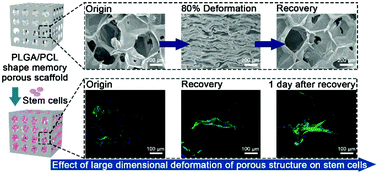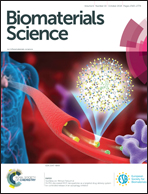Effects of large dimensional deformation of a porous structure on stem cell fate activated by poly(l-glutamic acid)-based shape memory scaffolds†
Abstract
Shape memory scaffolds are minimally invasive cell carriers that are promising biomaterials for tissue regeneration. Since cell fate is critical for successful regeneration, the influence of mechanostructural stimuli induced by shape memory on cell fate is worthy of investigation. In this study, we developed a poly(L-glutamic acid)-based (PLGA-based) shape memory porous scaffold by cross-linking PLGA with poly(ε-caprolactone)-diols (PCL-diols) and by using the particle leaching method. After regulating the cross-linking density and molecular weight of the PCL-diols, the scaffolds exhibited excellent shape memory properties around physiological temperatures. The interconnected porous structure not only enabled the scaffold to be deformed to 20% of its original size but also supported tissue invasion. In vivo results demonstrated that the PLGA-based scaffold degraded within 6 months. Cell fate studies indicated that large dimensional deformation of the porous structure during the shape memory process induced significant death, detachment and reorganization of stem cells but had negligible effects on stemness and proliferation. These results indicate that the PLGA-based shape memory porous scaffold is a potential cell carrier for tissue regeneration, and they are also meaningful to investigate the effects of mechanostructural stimuli on stem cell fate in porous structures.



 Please wait while we load your content...
Please wait while we load your content...